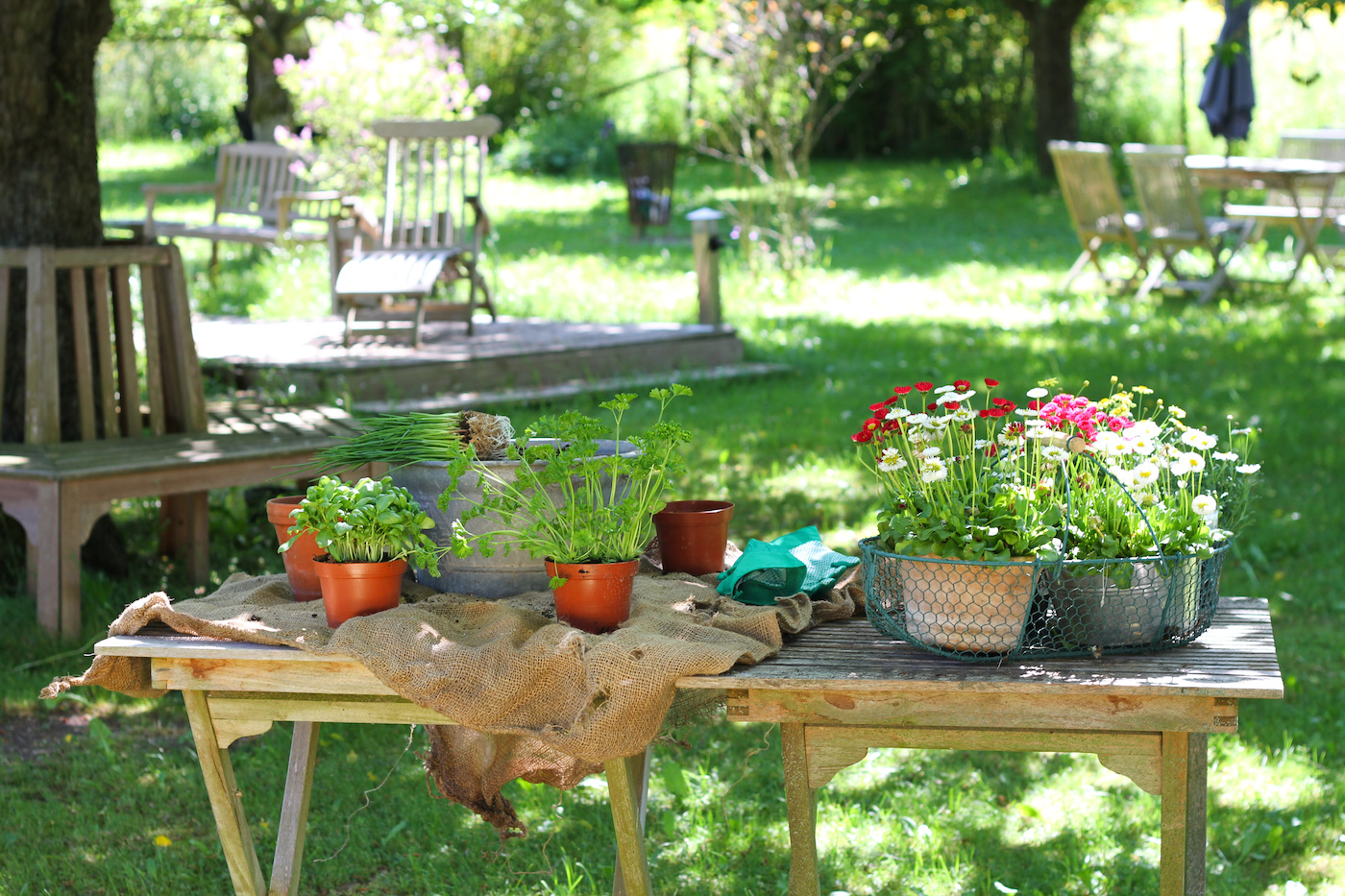May is the perfect time of year to get your home ready for the summer months ahead. There are plenty of maintenance tasks outside the home to keep you busy over the weekends. Below we’ve organized your landscaping tasks by plant zone, which will better help you get your plant and garden tasks done this month. Inside the home this is a great month to do your regular monthly maintenance tasks that help make your appliances and fixtures work better. If summer storms are a regular occurrence in your region, take some time to get your home organized and prepared for sudden wind or rain storms.

Interior Maintenance Tasks
Stay on top of these monthly tasks:
- Check and replace humidifier filters every 3 months (schedule an HVAC professional)
- Wipe down and dust surfaces (find a house cleaner)
- Check the batteries in your smoke alarm and other monitoring devices
- Thoroughly check showers and wet areas for mildew
May is the perfect month to:
- Switch out cool-weather bedding with warm-weather bedding (hire a house cleaner)
- Insulate and ventilate attic for the summer (find an attic insulation specialist)
- Test/service your AC system early (schedule an air conditioning service person)
- Check shutters for loose screws/parts, repair as necessary (call a handyman)
- Inspect window & door screens for damage, repair as needed (hire a window or door contractor)
If you have time, do this:
- Organize garage so your car can be parked safely inside when seasonal storms hit (hire a professional organizer)
- Check window seals and weatherstripping for water leaks
- Locate and repair cracks/faults along windows (call a window repair person)
- Clear any obstructions in attic fans & roof mounted turbine vents

Exterior Maintenance Tasks
Stay on top of these monthly tasks:
- Check roof and replace loose/missing/damaged shingles (call a professional roofer)
- Clean and treat roof and driveway of moss
- Check foundation for water accumulation or damage
May is the perfect month to:
- Consider installing awnings to shade your house (find an awning specialist)
- Uncover and clean outdoor furniture and patio (hire a pressure washing company)
- Clean and prep your grill
- Keep vines off of the house to prevent rot, insects & rooting (schedule a landscaping company)
If you have time, do this:
- Ensure that downspouts extend at least 3 feet away from foundation (call a gutter specialist)
- Inspect exterior paint for peeling, touch up as necessary (find an exterior painter)
- Examine and clean all weep holes

Landscaping Maintenance Tasks
April is a great month to walk around your property and see spring-blooming plants in full force. Because each region and climate has its own variety of plants and foliage, it’s a great idea to get to know which Plant Hardiness Zone you are located in. If you don’t see your city below, visit Plant Zones and enter your zip code. Use this information to gain greater detail about when to plant, when to prune or to find out what types of plants will grow best in your location.
- Atlanta
- Baltimore
- Boston
- Chicago
- Cleveland
- Dallas
- Denver
- Detroit
- Houston
- Indianapolis
- Los Angeles
- Miami/Ft. Lauderdale
- Minneapolis
- New York
- Philadelphia
- Phoenix
- Pittsburgh
- Portland
- Sacramento
- San Francisco
- San Jose
- Seattle
- St. Louis
- Tampa
- Washington D.C.
ZONE 4
Minneapolis, MN (Zone 4a)
- Plant seeds of cool weather crops for the 2nd and 3rd times
- Thin seedlings of crops planted earlier to their proper spacing
- Harden off transplants before you intend to plant them
- Plant warm season seeds & bulbs after the danger of frost has passed
- Mulch around plants and in rows to keep soil moist
- Monitor crops for insect and disease problems
- Pinch back mums to promote full, bushy plants
- Weed, weed, and weed some more
- Prune spring shrubs when they finish blooming
- Set stakes/supports next to your tall flowering plants
- Reseed any bare spots in your lawn
- Remove faded lilac blooms and prune if needed
- Move houseplants outside when danger of frost has passed
ZONE 5
Chicago, IL (Zone 5b)
- Prune early flowering deciduous shrubs
- Plant summer flowering bulbs (dahlias, cannas, gladiolas, tuberous begonias, lilies)
- Set stakes next to your tall flowering plants
- Plant cold hardy annuals, veggies, herbs & perennials (early May)
- Plant cold sensitive plants (mid-May or late-May)
Indianapolis, IN (Zone 5b)
- Move houseplants outdoors when danger of frost has passed
- Prune early spring-flowering trees & shrubs after flowers fade
- Plant balled-and-burlapped or container nursery stock
- Remove and destroy bagworms from trees & shrubs
- Mow lawn as needed to height of ~4 inches
- Begin organic rose care
- Divide/transplant perennials
- Plant tender ornamentals after danger of frost is past
- Mulch garden beds
- Pinch late-blooming perennials, and certain annuals
- Weed regularly
- Plant tomatoes, corn, peppers, eggplant, vine crops (mid-May)
- Thin seedlings of early-planted crops
- Harvest early plantings of radishes, spinach & lettuce
- Harvest asparagus and rhubarb
- Remove blossoms from newly set strawberry plants
- Thin fruit on apple trees to 8 inches apart (3 weeks after petals fall)
Denver, CO (Zone 5b)
- Plant annuals, perennials, shrubs & trees
- Consider planting butterfly bush, oleander, etc. to attract butterflies to the garden
- Keep plants especially well-watered this month, when rainfall is scarce
- Lay down a 2-3 inch layer of mulch
- Inspect irrigation systems for broken heads/lines; repair as necessary
- Fertilize landscape plants (roses, fruit trees & vegetables)
- Fertilize citrus trees (later in the month)
- Fertilize lawns
- Prune spring-flowering shrubs as blooms start to fade
- Move houseplants outdoors for the summer
- Plant warm-season vegetables (sweet potato, okra, tomatoes, squash, etc.)
- Plant heat-loving annuals (high elevations: delay until frost has passed)
- Deadhead faded flowers
- Pinch flower buds & remove growing tips to promote business
- Control seasonal pests: ants, cockroaches, bees & scorpions
Boston, MA (Zone 5b)
- Clean and seal decks
- Enjoy your first harvest of spring greens!
- Do a thorough weeding of your garden
- Lay down a healthy 3-inch layer of mulch when the soil has warmed
- Divide summer and fall-flowering perennials
- Start pinching garden mums as soon as shoots are 4-6 in. long
- Prune dead branches from shrubs
- Support floppy perennials with stakes/poles (delphiniums, peonies)
- Plant summer annuals, bedding plants & the mainstays of your veggie garden
- Protect tender tomatoes, peppers & eggplants from the cold
- Set up wire/fencing to control for rabbit (or rodent) damage
- Set up stakes/poles to support tomatoes, peas & pole beans
- Give the compost pile a turn or two after spring rains start
- Control seasonal pests: ants, cockroaches & spiders
ZONE 6
Cleveland, OH (Zone 6a), Detroit, MI (Zone 6b), St. Louis, MO (Zone 6a)
- Plant seeds of cool weather crops for the 2nd and 3rd times
- Thin seedlings of crops planted earlier to their proper spacing
- Harden off transplants before you intend to plant them
- Plant warm season seeds & bulbs after the danger of frost has passed
- Mulch around plants and in rows to keep soil moist
- Monitor crops for insect and disease problems
- Pinch back mums to promote full, bushy plants
- Weed, weed, and weed some more
- Prune spring shrubs when they finish blooming
- Set stakes/supports next to your tall flowering plants
- Reseed any bare spots in your lawn
- Remove faded lilac blooms and prune if needed
- Move houseplants outside when danger of frost has passed
New York, NY (Zone 6b), Pittsburgh, PA (Zone 6a), Washington DC (Zone 6b – 7a)
- Clean and seal decks
- Enjoy your first harvest of spring greens!
- Do a thorough weeding of your garden
- Lay down a healthy 3-inch layer of mulch when the soil has warmed
- Divide summer and fall-flowering perennials
- Start pinching garden mums as soon as shoots are 4-6 in. long
- Prune dead branches from shrubs
- Support floppy perennials with stakes/poles (delphiniums, peonies)
- Plant summer annuals, bedding plants & the mainstays of your veggie garden
- Protect tender tomatoes, peppers & eggplants from the cold
- Set up wire/fencing to control for rabbit (or rodent) damage
- Set up stakes/poles to support tomatoes, peas & pole beans
- Give the compost pile a turn or two after spring rains start
- Control seasonal pests: ants, cockroaches & spiders
ZONE 7
Baltimore, MD (Zone 7a), Philadelphia, PA (Zone 7a)
- Clean and seal decks
- Enjoy your first harvest of spring greens!
- Do a thorough weeding of your garden
- Lay down a healthy 3-inch layer of mulch when the soil has warmed
- Divide summer and fall-flowering perennials
- Start pinching garden mums as soon as shoots are 4-6 in. long
- Prune dead branches from shrubs
- Support floppy perennials with stakes/poles (delphiniums, peonies)
- Plant summer annuals, bedding plants & the mainstays of your veggie garden
- Protect tender tomatoes, peppers & eggplants from the cold
- Set up wire/fencing to control for rabbit (or rodent) damage
- Set up stakes/poles to support tomatoes, peas & pole beans
- Give the compost pile a turn or two after spring rains start
- Control seasonal pests: ants, cockroaches & spiders
Atlanta, GA (Zone 7b)
- Prune climbing roses back to 4-5 feet long
- Check for powdery mildew and black spot symptoms on rose bushes; treat infected plants as necessary
- Continue to fertilize roses
- Grow some herbs in your garden
- Finish planting warm-season vegetables and beans
- Stake your tomatoes to keep them growing upright
- Move houseplant outdoors, if you haven’t already
- Inspect undersides of camellia leaves for red spider mites & scale
- Test run your irrigation system before summer heat arrives
- Fertilize warm-season turf grasses (Zoysia & Bermuda prefer high-nitrogen)
- Tackle poison ivy and other perennial weeds early in the season
ZONE 8
Portland, OR (Zone 8b), Seattle, WA (Zone 8a)
- Fertilize young trees until they turn 3
- Plant summer-blooming exotics (begonias, gladiolus, callas, etc.)
- Weed and mulch
- Mow lawns every 5-7 days
- Pull weeds growing in between bricks/concrete
Dallas, TX (Zone 8a), Houston, TX (Zone 8b)
- Prune climbing roses back to 4-5 feet long
- Check for powdery mildew and black spot symptoms on rose bushes; treat infected plants as necessary
- Continue to fertilize roses
- Grow some herbs in your garden
- Finish planting warm-season vegetables and beans
- Stake your tomatoes to keep them growing upright
- Move houseplant outdoors, if you haven’t already
- Inspect undersides of camellia leaves for red spider mites & scale
- Test run your irrigation system before summer heat arrives
- Fertilize warm-season turf grasses (Zoysia & Bermuda prefer high-nitrogen)
- Tackle poison ivy and other perennial weeds early in the season
ZONE 9
Phoenix, AZ (Zone 9b)
- Plant annuals, perennials, shrubs & trees
- Consider planting butterfly bush, oleander, etc. to attract butterflies to the garden
- Keep plants especially well-watered this month, when rainfall is scarce
- Lay down a 2-3 inch layer of mulch
- Inspect irrigation systems for broken heads/lines; repair as necessary
- Fertilize landscape plants (roses, fruit trees & vegetables)
- Fertilize citrus trees (later in the month)
- Fertilize lawns
- Prune spring-flowering shrubs as blooms start to fade
- Move houseplants outdoors for the summer
- Plant warm-season vegetables (sweet potato, okra, tomatoes, squash, etc.)
- Plant heat-loving annuals (high elevations: delay until frost has passed)
- Deadhead faded flowers
- Pinch flower buds & remove growing tips to promote business
- Control seasonal pests: ants, cockroaches, bees & scorpions
Sacramento, CA (Zone 9b), San Jose, CA (Zone 9b)
- Fertilize young trees until they turn 3
- Plant summer-blooming exotics (begonias, gladiolus, callas, etc.)
- Keep up with weeding
- Lay down a fresh layer of mulch, as necessary
- Mow lawns every 5-7 days
- Pull weeds growing in between bricks/concrete
Tampa, FL (Zone 9b)
- Plant grass (Bermuda, zoysia, centipede & St. Augustine are common here)
- Water lawn three times a week
- Loosen and mix in compost to ready garden soil
- Sow a cover crop to fill bare spots in the garden (buckwheat & black-eyed peas work well)
- Harvest cool-season crops regularly; keep them watered & weeded
- Plant annual flowers (asters, cleome, cosmos, marigold, etc.)
- Pull spent pansies and replace with summer annuals
- Prune flowering trees and shrubs after they bloom
- Fertilize roses
- Consider planting red flowers to attract hummingbirds to your garden
- Control for veggie bugs: squash vine borer, flea beetle on eggplants & cucumber beetle
- Control for landscape bugs: bagworms, azalea lave bugs, leaf miners, scale & aphids
- Monitor and remove slugs and snails from garden
ZONE 10
Los Angeles, CA (Zone 10b)
- Control seasonal pests: ants, cockroaches, bees & scorpions
- Continue to plant container-grown trees, ground covers, perennial herbs & flowers
- Plant seeds for heat-loving plants (if you haven’t already)
- Prune winter & spring-flowering trees/shrubs once they stop blooming
- Limit pruning of desert legume trees
- Deadhead fading flower blossoms
- Apply a layer of mulch on flower beds & around tress
- Keep an eye out for yellow or pale leaves – a sign of iron chlorosis
- Clean up fallen fruit from citrus and other fruit trees
San Francisco (Zone 10a)
- Fertilize young trees until they turn 3
- Plant summer-blooming exotics (begonias, gladiolus, callas, etc.)
- Keep up with weeding
- Lay down a fresh layer of mulch, as necessary
- Mow lawns every 5-7 days
- Pull weeds growing in between bricks/concrete
Miami/Ft. Lauderdale, FL (Zone 10a)
- Plant grass (Bermuda, zoysia, centipede & St. Augustine are common here)
- Water lawn three times a week
- Loosen and mix in compost to ready garden soil
- Sow a cover crop to fill bare spots in the garden (buckwheat & black-eyed peas work well)
- Harvest cool-season crops regularly; keep them watered & weeded
- Plant annual flowers (asters, cleome, cosmos, marigold, etc.)
- Pull spent pansies and replace with summer annuals
- Prune flowering trees and shrubs after they bloom
- Fertilize roses
- Consider planting red flowers to attract hummingbirds to your garden
- Control for veggie bugs: squash vine borer, flea beetle on eggplants & cucumber beetle
- Control for landscape bugs: bagworms, azalea lave bugs, leaf miners, scale & aphids
- Monitor and remove slugs and snails from garden




